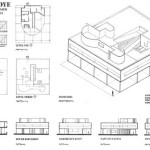House Architecture Plans: Essential Aspects for a Successful Home
When designing or renovating a home, architectural plans serve as the blueprint for every aspect of the structure. These comprehensive documents outline the design, layout, and specifications that guide the construction process. Understanding the essential aspects of house architecture plans is crucial for ensuring a successful and functional home.
1. Floor Plan
The floor plan defines the layout of the house, including the arrangement of rooms, walls, doors, and windows. It provides a bird's-eye view of the space, helping you visualize the flow and connections between different areas. A well-designed floor plan optimizes space utilization, creates natural transition zones, and ensures a logical and comfortable arrangement of rooms.
2. Elevations
Elevations depict the exterior appearance of the house from different sides. These drawings illustrate the height, shape, and design elements of the structure. They showcase the architectural style, facade details, windows, and door placements. Elevations play a vital role in determining the overall visual impact of the house and its relationship to its surroundings.
3. Sections
Sections provide vertical slices through the house, revealing the internal arrangement and construction details. These drawings show the relationships between different levels, ceiling heights, and spatial configurations. Sections demonstrate how the various components of the house fit together, ensuring structural integrity and visual coherence.
4. Roof Plan
The roof plan outlines the design, shape, and dimensions of the roof. It indicates the types of roofing materials, slopes, and any special features such as skylights or chimneys. The roof plan plays a significant role in the house's overall appearance, structural stability, and protection from the elements.
5. Foundation Plan
The foundation plan illustrates the design and specifications of the house's foundation. It shows the depth, materials, and dimensions of the footings, walls, and other structural elements that provide support to the structure above. A well-engineered foundation plan ensures the stability and longevity of the house.
6. Site Plan
The site plan depicts the relationship between the house and its surrounding property. It shows the location of the house on the lot, as well as driveways, walkways, patios, and other outdoor features. Landscape architects often collaborate with architects to create site plans that integrate the house's design with the natural environment.
7. Electrical Plan
The electrical plan outlines the electrical system of the house, including the placement of outlets, switches, lighting fixtures, and wiring. It ensures that there are adequate electrical outlets and lighting for all areas of the house and complies with safety codes.
8. Plumbing Plan
The plumbing plan illustrates the layout of the water supply and drainage systems. It shows the locations of pipes, fixtures, appliances, and septic tanks. A well-designed plumbing plan ensures an efficient and reliable water system that meets the needs of the occupants.
Conclusion
House architecture plans are indispensable tools for ensuring the successful design and construction of a home. By understanding the essential aspects of these plans, including the floor plan, elevations, sections, roof plan, foundation plan, site plan, electrical plan, and plumbing plan, you can create a home that meets your specific requirements and enhances your quality of life.

House Plans Home Floor Architecturalhouseplans Com

House Plans How To Design Your Home Plan

Where You Can Buy House Plans Live Home 3d

Plan 4525 Design Studio Architectural House Plans Floor Blueprints

Free House Design Home And Plans

How To Build A House From Paper Plaster Architectural Digest

Architectural House Plans Custom Home Plan Structural

House Plan Home Wiki Fandom

Floor Plan Wikipedia

Importance Of House Floor Plans In Architectural Design








